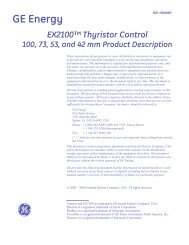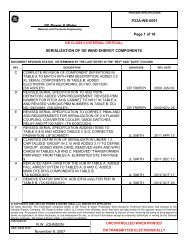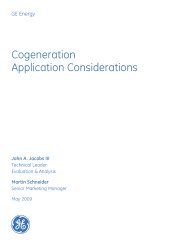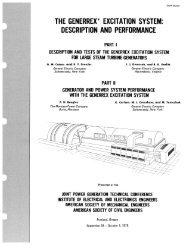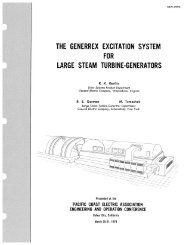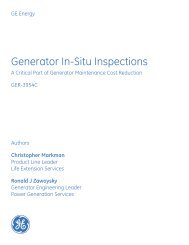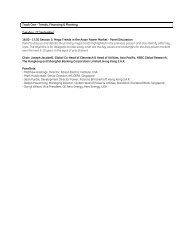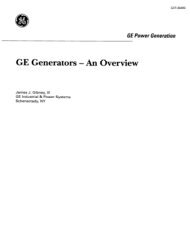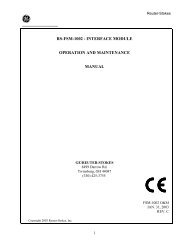GER 3568G - Dry Low NOx Combustion Systems for ... - GE Energy
GER 3568G - Dry Low NOx Combustion Systems for ... - GE Energy
GER 3568G - Dry Low NOx Combustion Systems for ... - GE Energy
You also want an ePaper? Increase the reach of your titles
YUMPU automatically turns print PDFs into web optimized ePapers that Google loves.
<strong>Dry</strong> <strong>Low</strong> NO x <strong>Combustion</strong> <strong>Systems</strong> <strong>for</strong> <strong>GE</strong> Heavy-Duty Gas Turbines<br />
Abstract<br />
State-of-the-art emissions control technology <strong>for</strong><br />
heavy-duty gas turbines is reviewed with emphasis<br />
on the operating characteristics and field<br />
experience of <strong>Dry</strong> <strong>Low</strong> NO x (DLN) combustors<br />
<strong>for</strong> E and F technology machines. The lean premixed<br />
DLN systems <strong>for</strong> gas fuel have demonstrated<br />
their ability to meet the ever-lower emission<br />
levels required today. Lean premixed technology<br />
has also been demonstrated on oil fuel<br />
and is also discussed.<br />
Introduction<br />
The regulatory requirements <strong>for</strong> low emissions<br />
from gas turbine power plants have increased<br />
during the past 10 years. Environmental agencies<br />
throughout the world are now requiring<br />
even lower rates of emissions of <strong>NOx</strong> and other<br />
pollutants from both new and existing gas turbines.<br />
Traditional methods of reducing <strong>NOx</strong> emissions from combustion turbines (water and<br />
steam injection) are limited in their ability to<br />
reach the extremely low levels required in many<br />
localities. <strong>GE</strong>’s involvement in the development<br />
of both the traditional methods (References 1<br />
through 6) and the newer <strong>Dry</strong> <strong>Low</strong> <strong>NOx</strong> (DLN)<br />
technology (References 7 and 8) has been well<br />
documented. This paper focuses on DLN.<br />
Since the commercial introduction of <strong>GE</strong>’s<br />
DLN combustion systems <strong>for</strong> natural-gas-fired<br />
heavy-duty gas turbines in 1991, systems have<br />
been installed in more than 222 machines, from<br />
the most modern FA+e technology (firing temperature<br />
class of 2420 F/1326 C) to field retrofits<br />
of older machines. As of May 1999, these<br />
machines have operated more than 4.8 million<br />
hours with DLN; and more than 1.4 million<br />
hours have been in the F technology. To meet<br />
marketplace demands, <strong>GE</strong> has developed DLN<br />
products broadly classified as either DLN-1,<br />
which was developed <strong>for</strong> E-technology<br />
(2000°F/1093°C firing temperature class)<br />
machines, or DLN-2, which was developed<br />
specifically <strong>for</strong> the F technology machines and<br />
is also being applied to the EC and H machines.<br />
Development of these products has required an<br />
intensive engineering ef<strong>for</strong>t involving both <strong>GE</strong><br />
Power <strong>Systems</strong> and <strong>GE</strong> Corporate Research and<br />
Development. This collaboration will continue<br />
as DLN is applied to the H machines and combustor<br />
development <strong>for</strong> <strong>Dry</strong> <strong>Low</strong> <strong>NOx</strong> on oil<br />
(“dry oil”) continues.<br />
This paper presents the current status of DLN-1<br />
technology and experience, including dry oil,<br />
and of DLN-2 technology and experience.<br />
Background in<strong>for</strong>mation about gas turbine<br />
emissions and emissions control is contained in<br />
the Appendix.<br />
<strong>Dry</strong> <strong>Low</strong> NO x <strong>Systems</strong><br />
<strong>Dry</strong> <strong>Low</strong> <strong>NOx</strong> Product Plan<br />
Figure 1 shows <strong>GE</strong>’s <strong>Dry</strong> <strong>Low</strong> <strong>NOx</strong> product offerings<br />
<strong>for</strong> its new and existing machines in<br />
three major groupings. The first group includes<br />
the MS3002J, MS5001/2 and MS6001B products.<br />
The 6B DLN-1 is the technology flagship<br />
product <strong>for</strong> this group and, as can be noted, is<br />
available to meet 9 ppm <strong>NOx</strong> requirements.<br />
Such low <strong>NOx</strong> emissions are generally not<br />
attainable on lower firing temperature<br />
machines such as the MS3002s and MS5001/2s<br />
because carbon monoxide (CO) would be<br />
excessive.<br />
The second major group includes the<br />
MS7001B/E, MS7001EA and MS9001E<br />
machines with the 9 ppm 7EA DLN-1 as the<br />
flagship product.<br />
The dry oil program focuses initially on this<br />
group.<br />
The third group combines all of the DLN-2<br />
products and includes the FA, EC, and H<br />
<strong>GE</strong> Power <strong>Systems</strong> ■ <strong><strong>GE</strong>R</strong>-<strong>3568G</strong> ■ (10/00) 1



